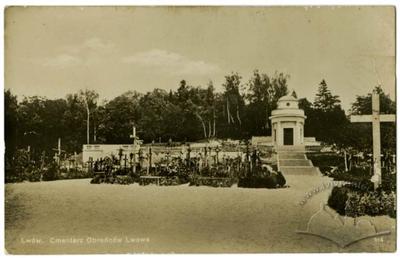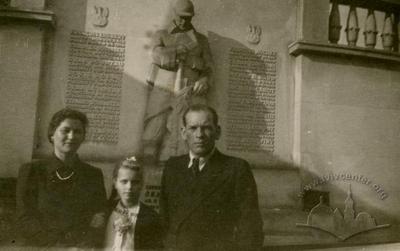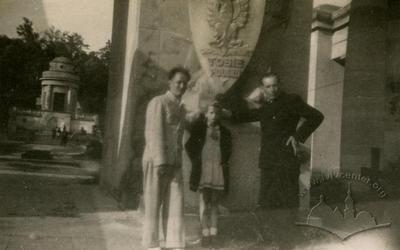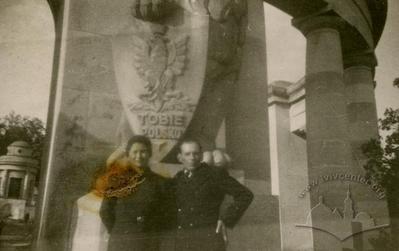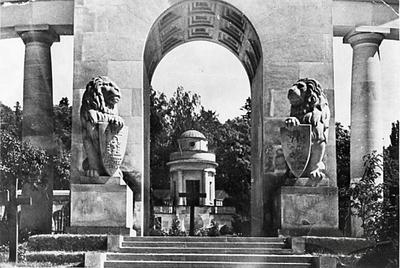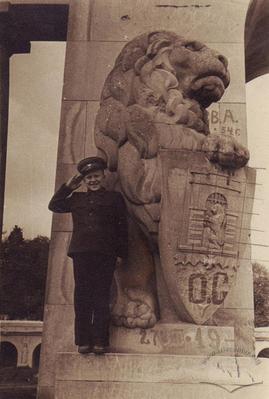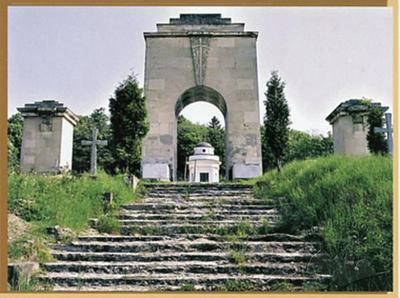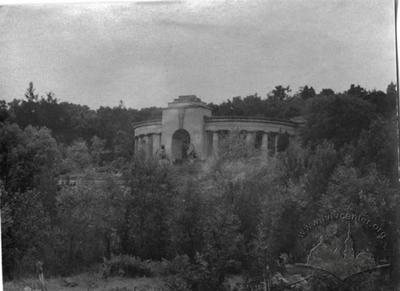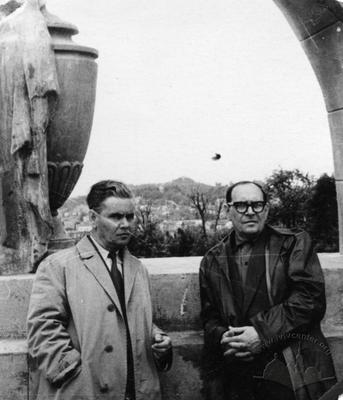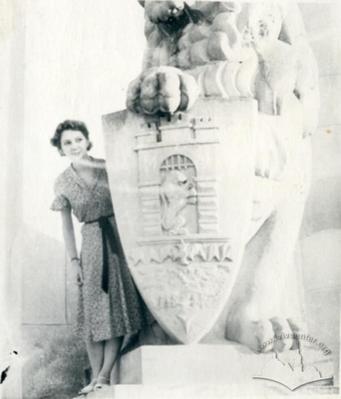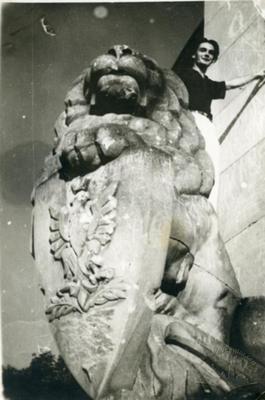Territory of Lychakiv cemetery – Polish military cemetery ID: 985
The Polish military memorial or the Cemetery of the defenders of Lviv, also called the Cemetery of Eaglets (Cmentarz Orląt), is located on a plot below Lychakivsky cemetery. The Poles who fought against the Western Ukrainian People’s Republic in 1918 and against the Bolsheviks in 1920, those fallen in the German-Polish war of 1939 and participants of the Resistance Movement (1922-1944) were buried there. In 1971 the cemetery was destroyed by the Soviet authorities; a part of its territory was occupied by Banakha street which was built in the same year. In 1989-2005 the memorial was partially reconstructed.
Story
The Polish military were for the first time buried on a plot below Lychakivsky cemetery on 24 November 1918; beginning from the spring of 1919, the remains of the killed soldiers were transferred there from temporary burial places. The first project of regulating the cemetery was designed by Władysław Kubik, a teacher of the Agricultural Academy at Dubliany. According to this project, terraces were to be arranged on the slope of Pohulianka, lanes were to be laid and trees planted. It was then that a wooden chapel was built and the cemetery was enclosed with a wooden fence.2318 participants of military actions in Lviv on 1-22 November 1918 and of the fight against the Bolsheviks in 1920, in particular, against the Red Army led by Semyon Budyonny are buried there in individual and common graves.
In 1921 a contest was organized for the best project of regulating the cemetery, and on 19 October the Kurier Lwowski newspaper sensationally reported that the first place was given to a project entitled “The White Roses”. It was designed by Rudolf Indruch, a 5th-year architecture student of the Lviv Polytechnic. Indruch was a former soldier of the Austro-Hungarian army and took part in the World War I as a senior lieutenant of field engineer troops.
According to Indruch’s project, a rotunda chapel was to be constructed on a hill in the center of the cemetery. From the side of Pohulianka, a massive Glorymonument was to be constructed in the shape of a triumphal arch with a semioval colonnade consisting of twelve columns. Stone statues of lions were to be placed on pedestals in front of the arch. Below the monument, three terraces with the graves of fallen soldiers were designed (fields 13-19 on the cemetery map); the shape of these terraces repeated the semioval shape of the colonnade.
Indruch was criticized by specialists for his bold architectural solution, pomposity and high cost of the project; however, the Society for the Protection of Graves of Polish Heroes signed a contract with him for making working drawings of the cemetery as well as for his artistic supervision of the construction. Thus, a general planning of the cemetery territory was performed under Rudolf Indruch’s guidance, the chapel was constructed in 1922-1924, and some monuments were built. The construction of the chapel was supervised by engineer Kazimierz Weiss who worked without being paid. Luna Amalia Drexler, a well-known sculptress, designed for the chapel’s altar a project of a statue depicting the Mother of God with little Jesus making his first steps.
The construction of catacombs lasted till October of 1932. After Rudolf Indruch’s death in 1927 the works were supervised by Antoni Nestorowski, a well-known constructor. The construction was complicated due to land slips and the high level of groundwater. It was necessary to counteract the slips making the foundations deeper. The construction of the Glory monument lasted for five years; it was solemnly opened on 11 November 1934.
To the left of the catacombs, there was a monument to American pilots of the Kościuszko Squadron built at the cost of the People’s Union of Poles of America. The monument was opened on 30 May 1932. It was constructed under a project designed by architect Józef Rudnicki and sculptor Józef Starzyński. American military pilots, officers Edmund Graves (d. 1919), Arthur Kelly (d. 1920), and Mac Callum (d. 1920) are buried there. To the right of the catacombs, French infantrymen who fought on the Polish side are buried. At first, there were seventeen French graves there but eventually only one remained, that of Jean Larguet; the remaining sixteen were transferred to France. A monument to the French soldiers was opened on 26 May 1928; it was built under a project designed by Józef Rużyński with the participation of sculptor Kazimierz Sokalski.
In 1925 the remains of an unknown warrior were solemnly transported to Warsaw and reburied in the Unknown Warrior’s Grave on the Saśka (now Józefa Piłsudskiego) square on 1 November. Only the grave place, covered by a marble slab made under a project designed by architect Kazimierz Sokalski, remained there.
Near the military cemetery, another cemetery was situated where participants of military actions who died in peace time were buried. The victims of the German-Polish war of 1939 and of the Resistance Movement in 1922-1944 were buried there. Rudolf Indruch, who designed the project of the Cemetery of the defenders of Lviv, was also buried there in 1927.
The Polish military cemetery was not destroyed during the war in 1939-1944. In the postwar period it started to gradually fall into decay; however, even in this condition the cemetery was a thorn in the flesh of the then communist regime. On 25 August 1971 the colonnade was destroyed with the help of tanks and military bulldozers. The arch and pylons were not destroyed as it was not possible to use dynamite due to the proximity of residential buildings. On the graves, where the Polish army veterans had been buried, a road (now Banakha street) was laid which separated the most pompous part of the cemetery. A brick fence wall was built around the cemetery. Stonemason’s workshops were arranged in the catacombs which later started to be gradually filled up with cemetery litter.
In 1990 the graves in the central part of the cemetery (fields 6-12 on the map) were cleared of building debris and litter by a Polish company called Energopol, thus laying a good groundwork for its restoration and complete reconstruction. With the concurrence of the local authorities of Lviv, the improvement and the first restoration works were started in the cemetery in 1997. Later, in 1999-2005, it was partially, with some changes, reconstructed.
Architecture
The cemetery consists of three principal monumental parts: a rotunda chapel for the celebration of liturgy, catacombs, and a Glory monument in the shape of a big colonnade (has not survived). Architect Rudolf Indruch did a good job using the complicated sloping local topography and arranged a cemetery on terraces.On the altar in the chapel, there was a sculpture depicting the Mother of God with little Jesus making his first steps; its project was designed by Luna Amalia Drexler, a well-known Polish sculptress. Basing on a plaster model of this sculpture, Andrzej Albricht, a Lviv sculptor, made a new one of sandstone.
The catacombs are situated slightly below the chapel and are connected with it by broad stone stairs on the right and on the left of the terrace. Each catacomb consisted of four vaulted crypts. The catacomb arcades stood on twelve pillars which were connected by Neoromanesque-style arches. On the pillars there were six figured reliefs which depicted standing angels with Virtuti Militari crosses on their chests and with crowns of thorns in their hands. A broad cornice above the pillars arches was decorated with sixteen reliefs depicting cherubs. 72 fallen warriors, which had been exhumed and selected by a special commission from various sectors of the front, were buried in eight crypts of the catacombs. The crypts were closed by stone slabs decorated with stone Art Nouveau carving. The names of the fallen soldiers with the dates of their birth and death were carved on these slabs.
To the left of the catacombs, there is a monument to American pilots of the Kościuszko Squadron constructed under a project designed by architect Józef Rudnicki and sculptor Józef Starzyński. To the right of the catacombs, French infantrymen who fought on the Polish side are buried. A monument to French soldiers was built in 1928 under a project designed by Józef Rużyński with the participation of sculptor Kazimierz Sokalski.
Related buildings and spaces
People
Andrzej Albricht – a Lviv sculptor.Andrzej Tadeusz Bonawentura Kościuszko – a Polish and American military and political figure, a national hero of Poland and of the USA.
Antoni Nestorowski – a constructor.
Arthur H. Kelly – an American military pilot, an officer.
Władysław Kubik – a teacher of the Agricultural Academy at Dubliany who designed the first project of regulating the Cemetery of the defenders of Lviv.
Edmund Pike Graves – an American military pilot, an officer of the American and Polish Air Forces.
Jean Larguet – a French infantryman.
Kazimierz Weiss – an engineer.
Kazimierz Sokalski – a sculptor, a co-author of the project of the monument to French soldiers.
Luna Amalia Drexler (Drexlerówna) – a sculptress, an artist and public figure.
Mac Callum – an American military pilot, an officer.
Rudolf Indruch – an architect and engineer, a captain of the Polish Army, who designed a project of the Cemetery of Eaglets.
Semyon Budyonny – a Soviet military leader.
Józef Rudnicki – an architect.
Józef Rużyński – a sculptor, a co-author of the project of the monument to French soldiers.
Józef Starzyński – a sculptor.
Sources
- A. Medyński, Przewodnik po cmentarzu Łyczakowskim (Lwów: Nakładem “Drukarni Polskiej” B. Wysłoucha, 1937), 52.
- Kurier Lwowski, 15.IV.1925.
- M. Orłowicz, Przewodnik po Lwowie (Lwów, 1920).
- Przewodnik po cmentarzu Obrońców Lwowa (Lwów, 1939).
- S. Nisieja, Dzielnica za Styksem (Wrocław, 1998).
Urban Media Archive Materials
